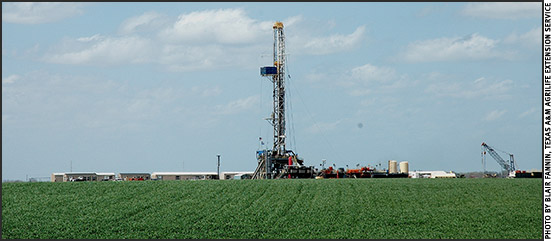
Mineral Rights Considerations
Oil and gas lease seminar discusses broad range of issues.
Despite an extended downturn in oil and gas prices, a large contingent of landowners recently attended a workshop at Texas A&M University in College Station to learn more about surface rights and leasing for exploration.
“The best thing a landowner can do when negotiating an oil and gas lease is to negotiate terms that best protect your surface,” said Tiffany Dowell Lashmet, Texas A&M AgriLife Extension Service agricultural law specialist, Amarillo.
If you’ve acquired land but not the mineral rights, an existing lease may have been executed in the 1950s or even earlier, Dowell Lashmet said. The best time to negotiate a surface agreement is when the oil and gas company needs something from you.
When negotiating an oil and gas lease, there are multiple items to consider, including payment for seismic holes shot on the property. If there is a water well on the property, seismic activity can possibly affect the formation, water quality, etc. A landowner/mineral owner should specify how many feet the oil and gas company can shoot holes, Dowell Lashmet said.
For example, a provision could call for seismic activity only within 200 feet of a building. There could also be seasonal restriction put into place to protect crop production, such as a wheat crop during growing season.
“You might also consider having restricted access points and specify no cutting of fences,” said Shannon Ferrell, associate professor of agricultural law, Oklahoma State University (OSU) Department of Agricultural Economics.
Ferrell suggested using aerial maps or imagery such as Google Earth to illustrate restricted-use areas.
Other items to specify in the lease include no trash or debris, no hunting or fishing, and no equipment storage in other areas of the property. Also, the lessor should specify that equipment must be removed within a set period after completion, he said.
Re-establishment or repair of rangeland to as close to original condition as possible should also be spelled out in the lease. Similarly, payments for certain actions such as building roads or digging pits should be considered. Another important consideration involves limiting use of surface substances by the mineral lessee, Ferrell said.
Lease negotiations can be aided by strength in numbers, he said. If there are multiple family members with shared mineral interests within a potential lease, they can join forces and share the cost of hiring an attorney to negotiate a lease.
In addition to discussing mineral leases, the workshop presenters also discussed pipeline easement negotiations. Dowell Lashmet said when negotiating pipeline rights of way, “understand your bargaining position.”
“Contact the State Comptroller’s office to determine who has eminent domain power,” she said. “If a party has eminent domain power, that means that they have the power to condemn property even if the landowner does not agree to the terms. In that situation, if the parties privately work out an agreement, end of story. But if they can’t, then condemnation proceedings are initiated in court.”
There are a number of procedural steps that occur before a condemnation suit is filed. In the end, the party seeking the easement makes a final written order and, after giving the landowner 14 days to respond, the party seeking the easement may file a condemnation action in the county court at law. A judge will appoint three special commissioners to hold a hearing and make a ruling on just compensation.
“Get a copy of the Landowner Bill of Rights. You will need this when dealing with eminent domain,” Dowell Lashmet said.
The workshop, which attendees drove an average of 100 miles to attend, was sponsored by AgriLife Extension and the OSU Department of Agricultural Economics, with grant funding from the National Institute of Food and Agriculture through the Southern Risk Management Education Center.

Editor’s Note: Blair Fannin is a media relationship specialist with Texas A&M AgriLife Communications.






